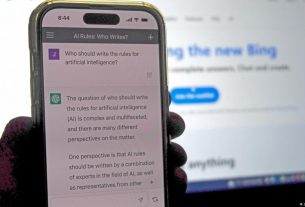A photographer is refusing a prestigious award after admitting to being a “cheeky monkey” and generating the prize-winning image using artificial intelligence.
The German artist Boris Eldagsen revealed on his website that he was not accepting the prize for the creative open category, which he won at last week’s Sony world photography awards.
The winning photograph depicted two women from different generations in black and white.
In a statement on his website, Eldagsen, who studied photography and visual arts at the Art Academy of Mainz, conceptual art and intermedia at the Academy of Fine Arts in Prague, and fine art at the Sarojini Naidu School of Arts and Communication in Hyderabad, said he “applied as a cheeky monkey” to find out if competitions would be prepared for AI images to enter. “They are not,” he added.
“We, the photo world, need an open discussion,” said Eldagsen. “A discussion about what we want to consider photography and what not. Is the umbrella of photography large enough to invite AI images to enter – or would this be a mistake?
“With my refusal of the award I hope to speed up this debate.”
He said this was a “historic moment” as it was the first time an AI image had won a prestigious international photography competition, adding: “How many of you knew or suspected that it was AI generated? Something about this doesn’t feel right, does it?
“AI images and photography should not compete with each other in an award like this. They are different entities. AI is not photography. Therefore I will not accept the award.”
Eldagsen suggested donating the prize to a photo festival hosted in Odesa, Ukraine.
The stunt comes at a time of intense debate over the use and implications of AI with some issuing apocalyptic warnings that the technology is on the brink of irreversibly damaging the human experience.
Recent advancements in the use of AI in chatbots, driverless cars, song-writing software and the development of pharmaceuticals has spurred the discussion. Google’s chief executive, Sundar Pichai, said concerns about AI had kept him awake at night and warned that the technology can be “very harmful” if incorrectly deployed.
A spokesperson for the World Photography Organisation said Eldagsen had confirmed the “co-creation” of the image using AI to them before he was announced as the winner.
“In our correspondence, he explained how following ‘two decades of photography, my artistic focus has shifted more to exploring creative possibilities of AI generators’ and further emphasising the image heavily relies on his ‘wealth of photographic knowledge’. As per the rules of the competition, the photographers provide the warranties of their entry.
“The creative category of the open competition welcomes various experimental approaches to image making from cyanotypes and rayographs to cutting-edge digital practices. As such, following our correspondence with Boris and the warranties he provided, we felt that his entry fulfilled the criteria for this category, and we were supportive of his participation.
“Additionally, we were looking forward to engaging in a more in-depth discussion on this topic and welcomed Boris’ wish for dialogue by preparing questions for a dedicated Q&A with him for our website.
“As he has now decided to decline his award we have suspended our activities with him and in keeping with his wishes have removed him from the competition. Given his actions and subsequent statement noting his deliberate attempts at misleading us, and therefore invalidating the warranties he provided, we no longer feel we are able to engage in a meaningful and constructive dialogue with him.
“We recognise the importance of this subject and its impact on image-making today. We look forward to further exploring this topic via our various channels and programmes and welcome the conversation around it. While elements of AI practices are relevant in artistic contexts of image-making, the awards always have been and will continue to be a platform for championing the excellence and skill of photographers and artists working in the medium.”
This content was originally published here.





